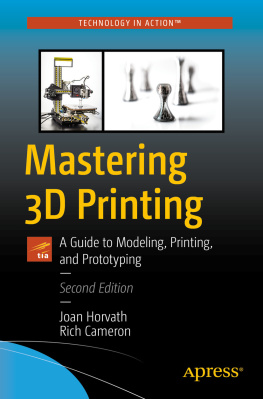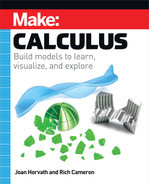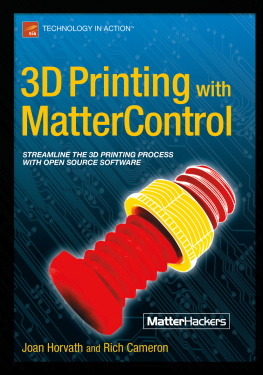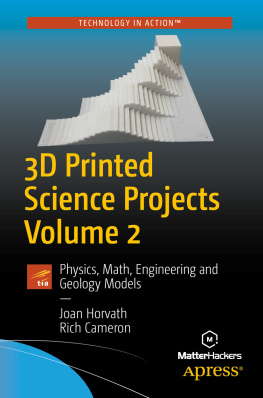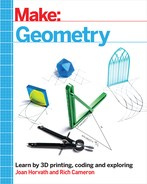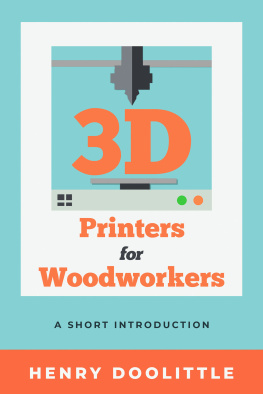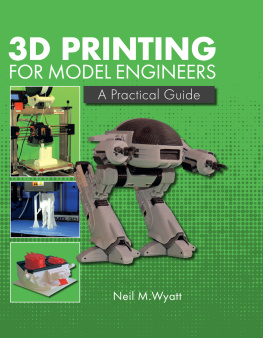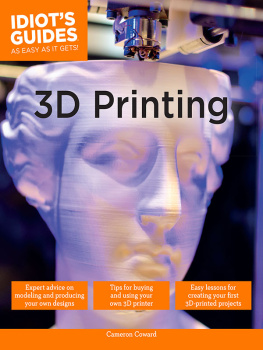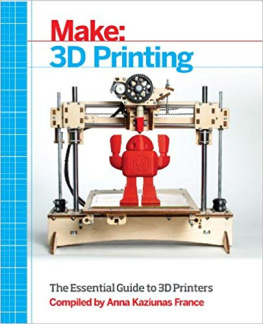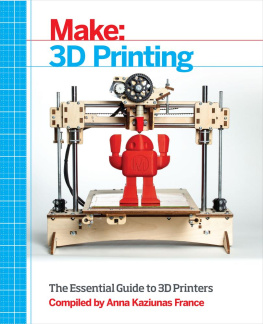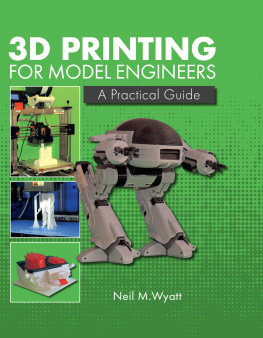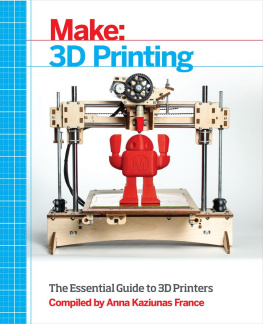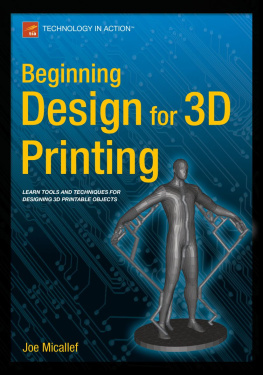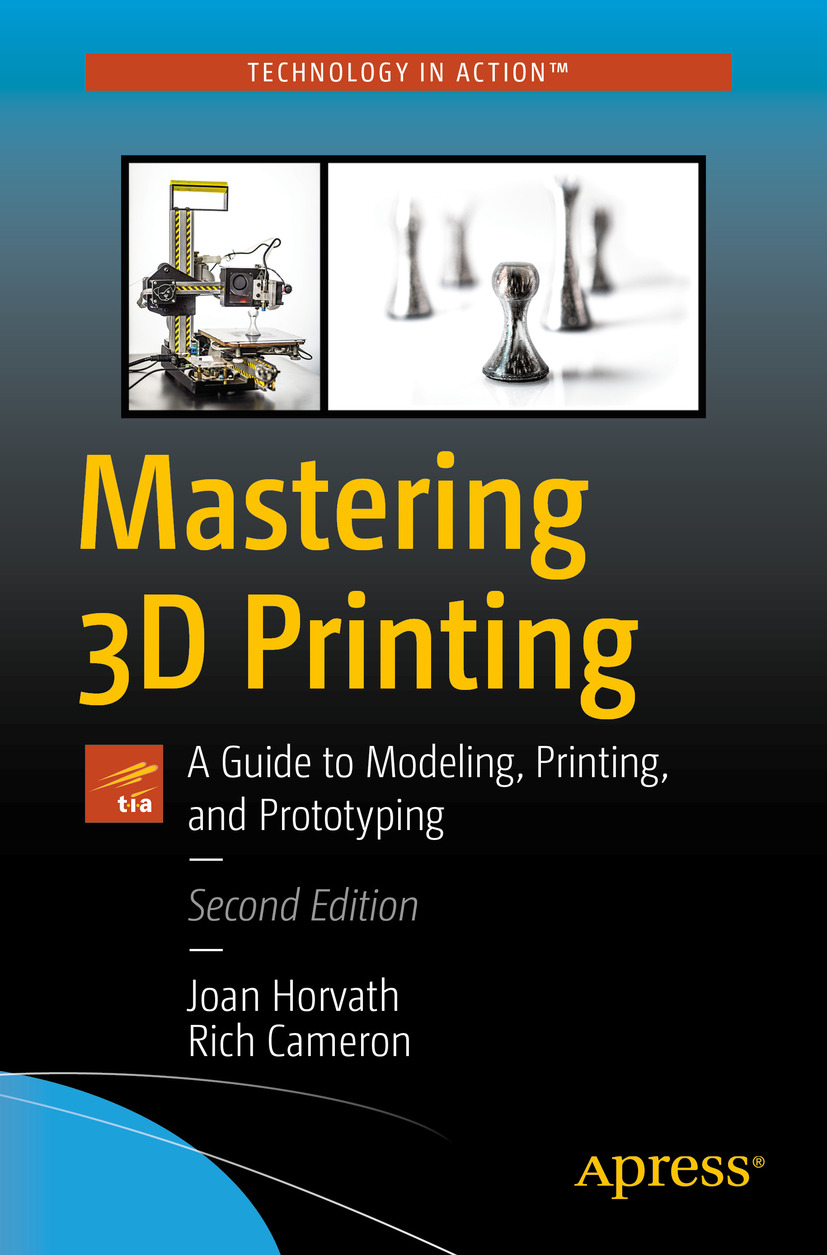Joan Horvath and Rich Cameron
Mastering 3D Printing
A Guide to Modeling, Printing, and Prototyping
2nd ed.
Joan Horvath
Nonscriptum LLC, Pasadena, CA, USA
Rich Cameron
Nonscriptum LLC, Pasadena, CA, USA
Any source code or other supplementary material referenced by the author in this book is available to readers on GitHub via the books product page, located at www.apress.com/978-1-4842-5841-5 . For more detailed information, please visit http://www.apress.com/source-code .
ISBN 978-1-4842-5841-5 e-ISBN 978-1-4842-5842-2
https://doi.org/10.1007/978-1-4842-5842-2
Joan Horvath, Rich Cameron 2020
This work is subject to copyright. All rights are reserved by the Publisher, whether the whole or part of the material is concerned, specifically the rights of translation, reprinting, reuse of illustrations, recitation, broadcasting, reproduction on microfilms or in any other physical way, and transmission or information storage and retrieval, electronic adaptation, computer software, or by similar or dissimilar methodology now known or hereafter developed.
The use of general descriptive names, registered names, trademarks, service marks, etc. in this publication does not imply, even in the absence of a specific statement, that such names are exempt from the relevant protective laws and regulations and therefore free for general use.
The publisher, the authors and the editors are safe to assume that the advice and information in this book are believed to be true and accurate at the date of publication. Neither the publisher nor the authors or the editors give a warranty, express or implied, with respect to the material contained herein or for any errors or omissions that may have been made. The publisher remains neutral with regard to jurisdictional claims in published maps and institutional affiliations.
Distributed to the book trade worldwide by Springer Science+Business Media New York, 233 Spring Street, 6th Floor, New York, NY 10013. Phone 1-800-SPRINGER, fax (201) 348-4505, e-mail orders-ny@springer-sbm.com, or visit www.springeronline.com. Apress Media, LLC is a California LLC and the sole member (owner) is Springer Science + Business Media Finance Inc (SSBM Finance Inc). SSBM Finance Inc is a Delaware corporation.
For everyone who contributed to the RepRap project to start this revolution.
Introduction
We have been astonished at how much the 3D printing industry has changed since the first edition of this book, which was published in 2014. Amazingly little has remained constant since then, except perhaps for a sense of wonder about what might be possible. That sense now is informed by more sober realities about the challenges that remain, as well as more realistic ideas about good applications.
In this book, we want to give you a path to get started with 3D printing, as well as enough insight to go a considerable distance down the road to using it to create useful things. 3D printing still is not all that straightforward, and we have tried to create a balance between telling you enough so you can get started without drowning in too much detail and not telling you enough. We have minimized the use of step-by-step screenshots, for example, since those get out of date quickly. Instead, we have given a few examples and tried to tell you what we were doing and why, so that you can do the same thing in whatever system you are using.
3D printing now is largely a materials game. Whether you want to print in metal or plastic, and the mechanical characteristics of the final part, will drive the choice of printer type (filament, resin, or powder) and thus price point. Printer hardware design innovation continues. However, we expect to see faster evolution of materials that will allow seamless creation of a prototype and first production run with a 3D printer, then moving on to injection molding for high-volume parts. Dentistry has emerged as a key early adopter, along with general product prototyping and creation of tooling and fixtures.
We expect this book to be used by a wide spectrum of readers, from K-12 teachers to plant managers. As such we have included a variety of examples to give you ideas on what is possible. Since we have heard that some people used the first edition as an ad hoc textbook, in this edition we include questions at the end of each chapter. If you are using this to learn on your own, you may find reflecting on the questions useful to focus your understanding as you go.
New in this edition is a discussion of printers that use liquid resin, which was far less ubiquitous in the consumer market in 2014 than it is now. By their nature and heritage, the many brands vary more among manufacturers than filament printers do, and we have accordingly tried to keep things generic but with enough information to get you started. We also dip into what is possible with powder-based printers, particularly those used to create metal parts.
The book is divided into three parts. Part 1 covers 3D printing hardware and software, starting with the basics of understanding when using a 3D printer is a good idea (Chapterwinds up the section with a discussion about how to post-process a print so that it is suitable for its ultimate use.
Part 2 is focused on designing models to be 3D printed. Like all manufacturing techniques, it is possible to design a part that is easy or hard to fabricate with a 3D printer. Chapterdescribes part geometries that require special handling.
Finally, Part 3 describes applications, starting with manufacturing plastic parts (Chapter) like specialty food printing and bioprinting.
We hope you find the book useful and a jumping-off point to getting started or to going to the next level. At the end of Chapter, we have noted other resources we have created. We hope you will invent the next amazing application for future editions of the book.
Acknowledgments
The consumer 3D printing ecosystem would not exist in its current form without the open source 3D printing hardware and software community. We appreciate how much we learn by looking at projects made by everyone at maker events large and small.
The Apress production team was there for us to solve problems as they arose and let us have great creative freedom otherwise. We dealt most directly with Natalie Pao, Jessica Vakili, and Welmoed Spahr, but we also appreciate the many we did not see. This book includes some materials from our other Apress 3D printing titles, notably the 2014Mastering 3D Printingand the 2018Mastering 3D Printing in the Classroom, Library, and Lab.
Much has changed from the first edition, but Diego Porqueras of Deezmaker, Metalnat Hayes, and Peter Dippells invaluable inputs back then still echo in this edition. We also particularly thank Michelle Lowman, the editor of the first edition, for taking a chance on us back in 2014 when this was so new.
We talked to many 3D printing professionals and maker-educators as we worked on this book, and we are grateful for the advice, images, and in some cases permission to use screenshots or photographs of their work, credited in more detail in the text. We want particularly to call out Steve Wygant of SeeMeCNC; Shelley Sun of MAKEiT, Inc.; Mara Hitner and Dave Gaylord at MatterHackers; Cody Casale of Casale Design LLC; Will and Jewelyn Co of CoKreeate; Nicole York of 3D Systems; Gabe Bentz of Slant 3D; David Shorey of Shorey Designs; Marius Kintel and the other OpenSCAD developers; and Ultimaker for allowing use of Ultimaker Cura screenshots. We are also grateful to the teams at Formlabs, SprintRay, The Virtual Foundry, and Procusini for discussions and images and to Desktop Metal and Markforged for insights for the metals chapter.

